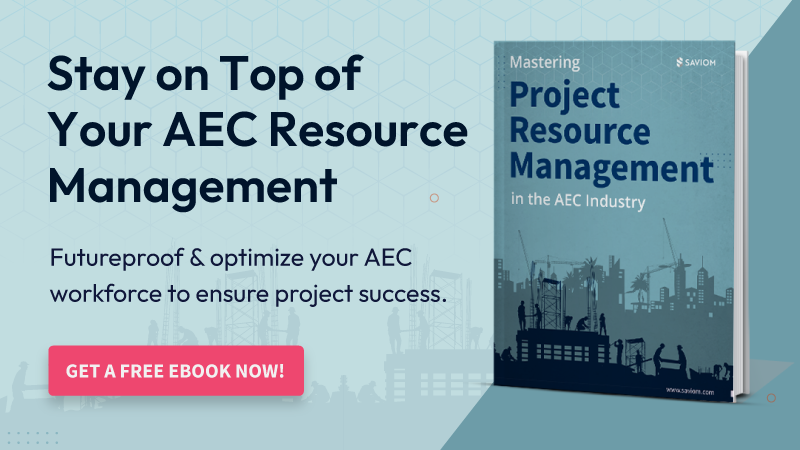What do you think makes an AEC project successful?
AEC firms leverage a diverse set of experts, from engineers and architects to on-site laborers and workers, to steer the projects to success. While hiring and retaining the right resources is pivotal, scheduling them for suitable tasks determines the timely competition and delivery. It helps enhance overall productivity, profitability, and quality of deliverables.
However, it is easier said than done.
The AEC industry is plagued with varied internal and external issues, such as process delays, budget constraints, climatic changes, price volatility, etc. Moreover, the pandemic has triggered increased raw material costs, global regulatory conditions, skill shortages, and unplanned attritions, making it challenging to optimize resource schedules.
Over one-fifth of the AEC firms globally are experiencing a schedule delay or cost overrun due to the pandemic. – KPMG’s 2021 Global Construction Survey
So, the question is – How do you optimize AEC resource schedules effectively?
This article discusses the strategies to optimize the schedules for AEC resources.
But before that, let’s first understand:
How is resource scheduling unique in AEC projects?
Resource scheduling involves identifying and assigning appropriate AEC resources to various project tasks at the right time and cost.
One critical factor that sets apart AEC resource scheduling is how the workforce is deployed during different phases of the project.
For instance, a budget analyst or financial advisor is scheduled in the Initiation Phase to estimate the overall budget and determine the project’s economic feasibility. At the same time, design architects and civil engineers are also scheduled to create a schematic design and identify the materials and equipment needed.
On the other hand, a ground preparation team is booked in the Pre-Construction and Procurement phase to evaluate the site’s condition and prepare it before the actual construction. In addition, a contractor is also required to rent, hire, or purchase tools and materials needed for construction.
Furthermore, subcontractors and vendors are expected to ensure the supply of requisite contingent workers, equipment, machinery, tools, etc. for the construction activities. At the same time, the architects, project managers, and engineers are deployed to carry out quality control inspections, detect and minimize discrepancies, and approve technical submittals to ensure the final structure is delivered as designed.
Apart from scheduling resources to different phases, AEC workers also work in different shifts, especially for large projects. It ensures that there is continuous activity round the clock and the project can be delivered as quickly as possible.
Moreover, resource scheduling in AEC also depends on the type of contract. For instance, if a construction worker is under a time-and-materials-based contract, they will be paid the agreed-upon price for the total hours or days worked. So, resource scheduling will be aimed at booking every worker for their available capacity to maximize overall revenue. On the contrary, if it’s a Fixed Price Contract, project managers tend to identify competent cost-effective resources, create the right pay-band mix, and control resourcing costs for a healthy profit margin.
Now that it is clear how resource scheduling is unique in the AEC industry let’s understand how it is crucial.
Significance of resource scheduling in AEC projects
By failing to prepare, you are preparing to fail ~ Benjamin Franklin
And when it comes to preparing for an AEC project, efficient resource scheduling is indispensable as it provides numerous benefits. Some of them include:
- Helps identify and allocate the best-fit AEC resources to every task throughout the construction project’s lifecycle.
- Facilitates resource booking as per the skills and availability of the AEC workforce to prevent issues like under/overutilization, skill mismatch, subpar quality, cost/budget overruns, billing losses, client dissatisfaction, etc.
- Contributes to the completion of the project within the stipulated time and budget through competent allocation and enhances client satisfaction.
- Allows uniform workload distribution to help maintain a healthy resource index and subsequently reduce unplanned attrition of the construction workforce.
Read More: All You Need To Know About Construction Resource Management
Given the importance of AEC resource scheduling, the following section elucidates the best strategies to make it efficient.
How to create an optimized resource schedule for AEC projects?
While firms can use several custom approaches for scheduling, the following are a few proven and time-tested strategies to create an optimized resource schedule.
Prepare a WBS and illustrate task interdependencies
An AEC project often has a high budget, and if not executed efficiently, it can cause substantial financial losses. Therefore, breaking down a project into small manageable tasks and setting milestones to measure progress is essential.
A WBS is a hierarchical representation of the project’s scope and all deliverables, including design, engineering, and services. In addition, it is also vital to understand the dependencies between tasks and determine the ones critical to complete the project successfully.
Here’s a simplified example of a house construction project for a better understanding. The table below shows some high-level tasks involved.

As evident from the table, tasks 1, 2, 4, and 6 lie in the critical path of the project. It implies that any delay in them will impact the entire project timeline. On the other hand, 3 and 5 are called slack tasks as they have some buffers. It implies that they can be delayed but not beyond a certain limit. This way, creating a work breakdown structure helps understand the tasks involved, identify the critical path, and schedule resources accordingly.
After creating the work breakdown structure, the AEC project manager should assess the nature of individual tasks and sub-activities. Based on that, they must determine the required specifications of the machinery items/equipment and skills/competencies of professionals. Further, the percentage of effort or capacity required from every worker or machine should also be factored in for effective scheduling.
Let’s take an elementary example of estimating human resource demands for a farmhouse construction project. The requisites include an architect, a design engineer, and 10 workers for creating the design and laying the foundation. Following that, 50 workers are required to build walls and the roof. Lastly, it requires two painters, one carpenter, a plumber, and an electrician to complete internal and external furnishing. So, one can document human resource requirements for the entire project this way.
Consider workers’ availability and vacation prior to booking
Since AEC projects require workers of varying skills in different phases, it is essential to consider their availability beforehand. However, a failure to do so can result in double bookings and project delays. So,
Managers should check the AEC resource schedule before booking and consider sick leaves, vacation days, and public holidays.
In addition, managing and tracking construction workers’ availability beforehand ensures scheduling per their capacity and avoids work overload. In addition, it helps deploy skilled AEC resources to suitable projects at the right time and cost. It further ensures optimal utilization of every worker, preventing productivity loss and burnout.
Read More: What is Resource Booking, and How Does Drag and Drop Make it Effective?
Assign AEC professionals with matching skills to project tasks
Once construction managers ensure the availability of skilled resources, the next step is assigning them to tasks based on the duration, criticality, and resources’ skills. Besides, project managers should communicate the responsibilities to the AEC resources. In addition, managers must ensure that the tasks align with the skills and competencies of construction resources.
Assigning an under-skilled AEC resource to a critical task can compromise quality and cause schedule overruns. For instance, if a bricklaying mason is given the job of choosing the right material for the roof and laying it, they may fail to do so efficiently. On the contrary, booking a critically skilled professional to admin tasks like billing entry can lead to cost escalations, lower employee engagement, and result in unplanned attrition. Thus, skills and competencies form an important factor in scheduling professionals.
Create the right mix of permanent and contingent construction workers
Due to high resourcing costs and lack of opportunities, most AEC firms, especially small-sized ones, find it challenging to maintain a steady talent pool, including niche skilled resources. However, the absence of the right skilled workforce to fulfill critical project demands can affect their growth and sustainability. Therefore, AEC firms must leverage a contingent workforce to cater to specific project demands.
For example, a geotechnical engineer evaluates ground, assesses on-site soil properties like slope stability, load-bearing capacity, etc., and determines the type of earthwork needed. These engineers are often deployed in construction projects like building roads, railway lines, bridges, etc. Such critical AEC resources can be hired on demand to reduce overhead costs. Thus, establishing the right mix of permanent and on-demand workers help control project costs and increase billable opportunities, enhancing the bottom line.
Optimize AEC resource schedules to prevent burnouts
In some cases, construction workers might get booked on multiple tasks, stretching their schedules thin, resulting in work overload, increased stress, and burnout. Hence, optimizing AEC resource schedules is essential for every AEC firm to prevent project delays. For that, managers can track their schedules periodically and determine if any worker is booked exceeding their capacity for a given duration.
If there is any variance,
Managers can implement appropriate optimization techniques based on the nature of the tasks to ease out the excess workload.
For example, for tasks with flexible timelines, like selecting the paint, managers can leverage resource leveling to adjust the start and end dates. In case of tasks with stringent deadlines like laying the foundation, managers can implement resource smoothing to pull in additional construction resources to assist the current team and ensure on-time completion. These optimization techniques will ensure uniform workload distribution and increase productivity.
Read More: How can you Implement Workforce Optimization to Improve Productivity?
Formulate a risk mitigation plan to address AEC resource constraints
AEC projects are prone to accidental hazards, calamities, natural disasters, etc., resulting in resource constraints at various stages. For instance, workers might get injured due to an on-site accident like slips or falls. Or some workers may go on unplanned leave or quit the organization in the middle of the construction work. In global projects, the supply chains of raw materials may get affected due to socio-political reasons, import/export bans, or civil crises.
Therefore, formulating a robust risk mitigation framework ready to handle these situations is imperative. For instance, managers can create a backup/reserve workforce to replace the professionals when required. They can also train the benched personnel on critical skills to schedule them on short notice. Further, one can set aside a reserve budget to switch to a vendor in an emergency and continue the project uninterrupted. Thus, a risk management framework helps mitigate potential risks efficiently and prevent them from derailing the project.
Given the best scheduling practices, let’s consider how resource management software can come in handy.
How can resource management software help optimize resource scheduling in AEC projects?
An advanced resource management solution is the key to resolving all the resource-related constraints and streamlining scheduling in the AEC industry. Here’s how.
First, the tool provides a bird’s eye view of resources’ skills, competencies, experience, cost rate, etc., eliminating silos of data caused by registers or Excel spreadsheets. It also provides advanced filters to narrow down the search for the right AEC professional for a given job.
Second, the tool provides capacity-vs-demand reports that allow managers to view upcoming demands and determine the existing skill gaps. Accordingly, they can use suitable internal or external channels such as training, upskilling, or hiring a contingent or permanent AEC workforce to fill them proactively.
Moreover, the project vacancy reports help analyze the nature of demands to determine if they are critical/generic or recurring/one-time. Based on that, the managers can hire and build the right mix of a permanent and contingent construction workforce to control the overall project resourcing costs while retaining deliverable quality.
Third, heat maps and Gantt charts provide insights into individual AEC employees’ schedules and real-time utilization levels to identify overworked employees and take appropriate measures to ease the workload.
Fourth, the tool provides reports like forecast-vs-actual financials that help track critical project financial attributes, including costs, revenue, profit margins, and overheads periodically. Based on the insights, the managers can identify any significant negative variance and act proactively to minimize it.
Conclusion
If a building looks better under construction than when it does when finish, then it’s a failure. ~ Douglas Couplar, a Canadian novelist and designer
An optimized resource schedule is one of the pivotal factors in creating a “perfect” building. Following the above-mentioned practices and implementing an advanced resource management solution can help you master the art of resource scheduling.
So, what’s your approach to creating an optimized resource schedule?
The SAVIOM Solution
SAVIOM is the market leader in helping multinational clients manage their resources efficiently and effectively. With over 20 years of experience, this Australian-based MNC has a global presence across 50 countries and has helped 100+ clients with their Workforce Planning Software. Saviom also provides tools for Enterprise Project Resource Management, Project Portfolio Management, and Professional Service Automation.












